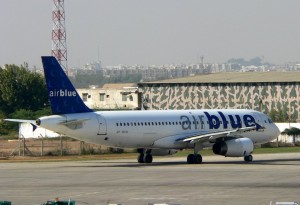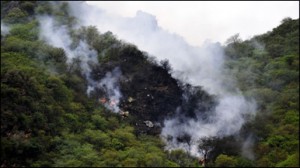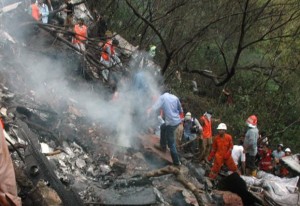And it was all over the news this morning, I’ve been receiving different texts from my friends about the plane crash but I didnt know the case is very different. I woke up and turned on a news channel and I was astounded to know that a massive passenger plane has collided Margalla hills surrounded by Islamabad. I had no idea at that time about the massive holocaust of humanity in the name of Plane crash. By the after-noon it was evidently declared that nobody survived the plane crash, Thus killing all 152 people on board.

I’ve been deeply analysing the plane crash as it was for the first time that a big jet with so many passengers on board has crashed into the area where planes are not allowed to go. Beside this, so many questions are still unanswered. I’ve been thinking why the plane was directed to move towards the Blue Area side of Islamabad, as that area is usually regarded as VIP area where no plane can fly. Plus it has all important buildings of Pakistan like Supreme Court, Parliament House, Prime Minister House and the President House. This is still an unsolved mystery for me that why the plane was sent to ‘No Go Area’. Please dont forget that Naval Headquarters and PAF complex is also located in that Area.
 That was one aspect of my vision and analysis about the plane crash, however on the other side of coin, Air Pocket could be the other reason. May be a lot of us are unfamiliar with this term ‘Air Pocket’ which is also known as Air Turbulence. Air Turbulence is a phenomena in which an aeroplane can descend as low as 10,000 feet in the time period of few seconds. Air Turbulence is basically a stream of air in irregular motion that normally cannot be seen and often occurs unexpectedly. It can be created by a number of different conditions. The most common encounter is flying in the vicinity of thunderstorm. In fact, a flight through a patch of cloud will often jostle the airplane. Flying over mountainous area with a prevailing wind is another major cause of air turbulence. Other causes come from flying near to jet streams at high altitude, in a frontal system or where temperature changes in any air mass in the sky.
That was one aspect of my vision and analysis about the plane crash, however on the other side of coin, Air Pocket could be the other reason. May be a lot of us are unfamiliar with this term ‘Air Pocket’ which is also known as Air Turbulence. Air Turbulence is a phenomena in which an aeroplane can descend as low as 10,000 feet in the time period of few seconds. Air Turbulence is basically a stream of air in irregular motion that normally cannot be seen and often occurs unexpectedly. It can be created by a number of different conditions. The most common encounter is flying in the vicinity of thunderstorm. In fact, a flight through a patch of cloud will often jostle the airplane. Flying over mountainous area with a prevailing wind is another major cause of air turbulence. Other causes come from flying near to jet streams at high altitude, in a frontal system or where temperature changes in any air mass in the sky.Two third of turbulence-related accidents occurs at or above 30,000 feet. Generally, flying through turbulence of the milder nature, if prolonged, can be fairly uncomfortable to the passengers. If such turbulence were detectable by the weather radar or from weather forecast, pilots would avoid them by deviating off track. There were number of air planes which experiences air crash because of Air Turbulence but they were rare in nature.
 According to aviation consultancy Ascend. Examples include the crash of an Austral airlines McDonnell Douglas in Uruguay with the loss of 69 passengers and five crew in 1997. A Fokker aeroplane crashed shortly after taking off from Rotterdam airport in 1981, killing 13 passengers and four crew. One of the earliest cases involved a BOAC (later British Airways) Boeing 707 near Mount Fuji in Japan. The BOAC flight from Tokyo to Hong Kong flew into extreme turbulence and crashed in March 1966, killing 113 passengers and 11 crew. An investigation reported that the likely cause of the disaster was that “the aircraft suddenly encountered abnormally severe turbulence which imposed a gust load considerably in excess of the design limit.”
According to aviation consultancy Ascend. Examples include the crash of an Austral airlines McDonnell Douglas in Uruguay with the loss of 69 passengers and five crew in 1997. A Fokker aeroplane crashed shortly after taking off from Rotterdam airport in 1981, killing 13 passengers and four crew. One of the earliest cases involved a BOAC (later British Airways) Boeing 707 near Mount Fuji in Japan. The BOAC flight from Tokyo to Hong Kong flew into extreme turbulence and crashed in March 1966, killing 113 passengers and 11 crew. An investigation reported that the likely cause of the disaster was that “the aircraft suddenly encountered abnormally severe turbulence which imposed a gust load considerably in excess of the design limit.”The mystery still remains unsolved and the questions are still there to answer but initial investigations has to under-go in order to fetch out the conclusion. I’ve extreme sympathy with the families of passengers who were on board. There’s nothing that can compensate human loss but yet when there is loss, it should be investigated so that no-one else in future face something like that.
No comments:
Post a Comment